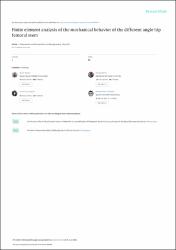| dc.contributor.author | Güvercin, Yılmaz | |
| dc.contributor.author | Yaylacı, Murat | |
| dc.contributor.author | Ölmez, Hasan | |
| dc.contributor.author | Yaylacı, Ecren Uzun | |
| dc.contributor.author | Özdemir, Mehmet Emin | |
| dc.contributor.author | Dizdar, Ayberk | |
| dc.date.accessioned | 2022-11-11T07:26:39Z | |
| dc.date.available | 2022-11-11T07:26:39Z | |
| dc.date.issued | 2022 | en_US |
| dc.identifier.citation | Guvercin, Y., Yaylaci, M., Olmez, H., Yaylaci, E.U., Ozdemir, M.E. & Dizdar, A. (2022). Finite element analysis of the mechanical behavior of the different angle hip femoral stem. Biomaterials and Biomechanics in Bioengineering, 6(1), 29-46. http://doi.or/10.12989/bme.2022.6.1.029 | en_US |
| dc.identifier.issn | 2465-9835 | |
| dc.identifier.issn | 2465-9959 | |
| dc.identifier.uri | http://doi.or/10.12989/bme.2022.6.1.029 | |
| dc.identifier.uri | https://hdl.handle.net/11436/6974 | |
| dc.description.abstract | Femoral stems with proximal metaphyseal involvement are commonly used total hip replacement components with very good results. In this study, total hip arthroplasty (THA) application was analyzed using a three-dimensionally modeled human hip joint by finiite element method. The aim of the study is to investigate the effects of changes in the direction of the femoral stem on these complications. Finite element analysis is performed on a model of femur bone by varying the femur angles. Finite element models were prepared for three different positions (5 degrees varus, neutral, 5 degrees valgus) on the femur without cement during walking motions. A sinusoid dynamic load with amplitude between 300 N and 1700 N and with a frequency of 1 Hz was applied. The stresses, strains and deformations that occurred on the femur and stems were determined at the end of the finite element analysis and compared to each other. Considering the results of strain, strain and deformation in the study, it is seen that the closest results to the natural load bearing of the femur are in the valgus position. The results obtained in the neutral position are also close to these results. In the metaphyseal points involving the femur stem, the highest values were found in the varus position. In all three positions, the femoral stem provides the transfer of the load from the proximal femur. The lowest stress, strain and deformation results were obtained in the valgus position, especially in the metaphyseal where the prosthesis is involved. It is seen that there are values close to this in the neutral position. This situation may be thought to result in a decrease in the proximal stress shield, an increase in bone protection compared to the varus position, a long-term loosening and a decrease in periprosthetic fracture. | en_US |
| dc.language.iso | eng | en_US |
| dc.publisher | Techno-Press | en_US |
| dc.rights | info:eu-repo/semantics/openAccess | en_US |
| dc.subject | Biomechanics | en_US |
| dc.subject | Fmite element method | en_US |
| dc.subject | Total hip arthroplasty | en_US |
| dc.title | Finite element analysis of the mechanical behavior of the different angle hip femoral stem | en_US |
| dc.type | article | en_US |
| dc.contributor.department | RTEÜ, Tıp Fakültesi, Cerrahi Tıp Bilimleri Bölümü | en_US |
| dc.contributor.institutionauthor | Güvercin, Yılmaz | |
| dc.contributor.institutionauthor | Yaylacı, Murat | |
| dc.identifier.doi | 10.12989/bme.2022.6.1.029 | en_US |
| dc.identifier.volume | 6 | en_US |
| dc.identifier.issue | 1 | en_US |
| dc.identifier.startpage | 29 | en_US |
| dc.identifier.endpage | 46 | en_US |
| dc.relation.journal | Biomaterials and Biomechanics in Bioengineering | en_US |
| dc.relation.publicationcategory | Makale - Uluslararası Hakemli Dergi - Kurum Öğretim Elemanı | en_US |


















